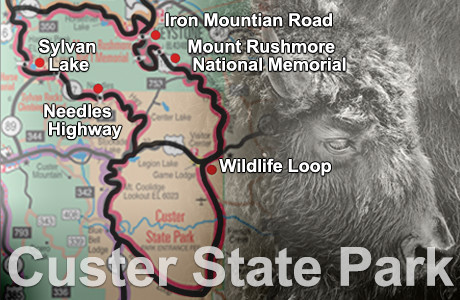Fall Color Tour of Custer State Park, Mt. Rushmore & Crazy Horse
For an awe-inspiring, eye-popping autumn experience plan your own fall color tour of our national icons starting with Custer State Park, a 71,000-acre park home to abundant wildlife including 1,400 free-roaming Bison. This loop tour starts in Keystone, home of Mt Rushmore and takes you into Custer State Park via Iron Mountain Road. Experience the hairpin curves, wildlife, hiking, and three stone carved tunnels that perfectly frame impressive views of Mt Rushmore in the distance. This is by far a one-of-a-kind visual of the famous monument. Drive the road that engineers once said couldn’t be built.
In addition to its “Pigtail Bridges”, you will see large stands of birch, aspen and burr oak that provide a gorgeous backdrop along this peaceful paved byway. Stop at the new Visitor Center and the State Game Lodge, the summer White House for both Calvin Coolidge and Dwight Eisenhower.

Continue on to the Wildlife Loop Road. Watch for the buffalo, antelope, wild burros, and deer. Many of the elms are a stark yellow contrast to the darker oaks. The ash trees have the speckles of orange like sparks from a campfire.
As you near Mt Coolidge you will notice the dry orange colors of the burr oaks, the greens and yellow of the trees and the Purple Woodbine vines climbing high into many trees. Mt. Coolidge rises high above the buffalo in Custer State Park. A 1.7-mile gravel road leads visitors to the top of the mountain. The road has several twists and turns as it spirals its way to the top. Mt. Coolidge is an active fire tower and serves as a communication center for Custer State Park.
Stone steps lead up to a viewing platform with coin-operated binoculars. The view from this vantage point, at 6,023 feet, is awesome. On a clear day, you can see the Badlands nearly 90 miles in the distance. Even with the naked eye, visitors can see Mt. Rushmore, Black Elk Peak, and Crazy Horse Memorial. Observe the colors of nature at every location from this historic tower.
Continue to the Gordon Stockade. The Gordon party came to the Black Hills in the summer of 1874 searching for gold. They built a log fort on French Creek, which served as their base camp to protect them from possible Lakota attacks. The Gordon party was short lived as the US Cavalry came and evicted them after five months. Following their eviction, a flow of fortune seekers came to these newly discovered mountains of gold. It was more than the army could control and within two years, nearly 10,000 settlers illegally inhabited the Black Hills. Today, as you approach the Gordon Stockade, interpretive signs tell the story of this short-lived illegal occupation in 1874 and 1875.
You will be traveling on Highway 89 to Sylvan Lake where you will experience one of the best drives for fall foliage. You will observe the rich gold of the aspen and the burr oaks scattered within the ponderosa pines.
As you travel through the Needles Highway the rich fall colors are from the paper birch and quaking aspen trees. Besides the bright purples of the Dogwood and the soft green of the Russian Olive will keep the color seekers eyes occupied for a while. Aspen and birches are as common as the curves in the road.
One of the most prominent features is the Needles Eye, which reaches 30-40 feet in the air with a three-foot wide slit. The Needles Eye is an excellent spot for climbing and for taking pictures. Observe Harney Peak looming overhead and the waters of Sylvan Lake sparkling below with a sprinkling of dazzling color mixed in. Stop for lunch at the Sylvan Lake Lodge at the Lakota Dining Room or carry a picnic.
Traveling from Sylvan Lake Lodge, you’ll head West on Hwy 87 to 385 out of the park. At the junction, travel a few miles south to Crazy Horse Memorial, a mountain monument under construction depicting the Oglala Lakota warrior, Crazy Horse. The memorial is also home to the Indian Museum of North American and the Indian University of North America.
Return to Mount Rushmore via Hwy 385 and 244 and take in the majestic 60-foot faces of four U.S. presidents gazing out over South Dakota’s Black Hills as a symbol of American democracy. This national treasure tells the story of the United States’ rich history, rugged determination, and lasting achievement. Your American pride will swell as you explore the extensive grounds, interactive learning centers, guided and self-guided tours, restaurants, and gift shops. From the Grand View Terrace, visitors get spectacular views of Washington, Lincoln, Jefferson, and Roosevelt. For a closer view, visitors can walk the half-mile Presidential Trail, which loops along the base of the mountain. The Lincoln Borglum Museum contains interactive interpretive exhibits and a great bookstore.
